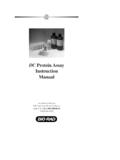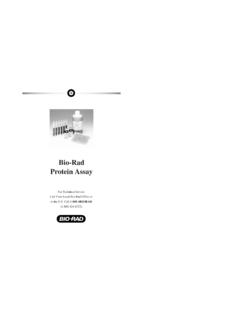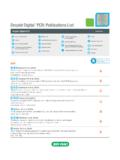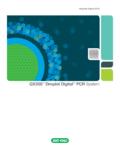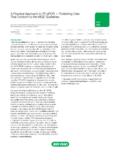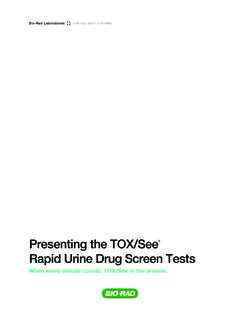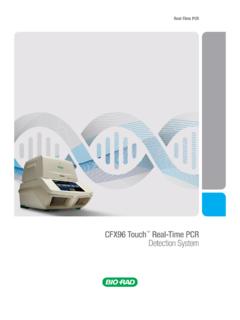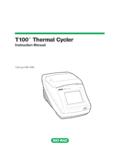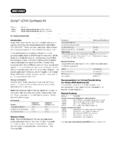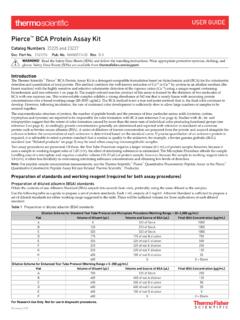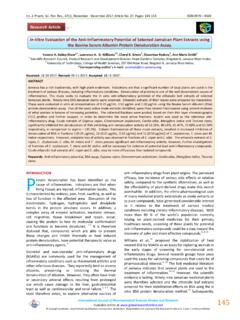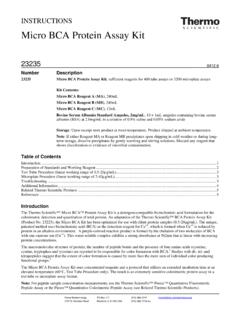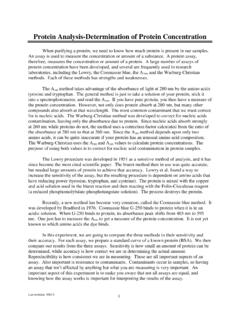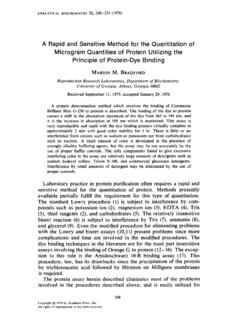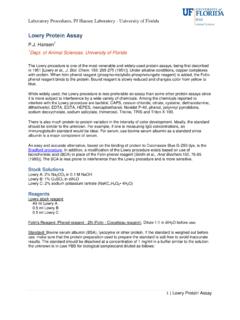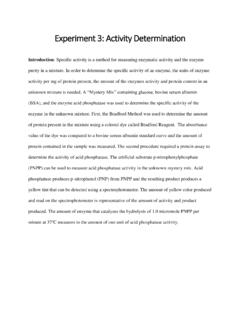Transcription of 1-800-4BIORAD Protein Assay Bio-Rad
1 Bio-RadProtein AssayFor Technical ServiceCall Your Local Bio-Rad Office orin the Call 1-800-4 BIORAD(1-800-424-6723)LIT33C 8/31/98 02:25 PM Page aTable of ContentsSection 1 Introduction .. Required but Not 2 Instructions .. Reconstituting the Standard .. Procedure .. Procedure .. Plate Protocols ..6 Section 3 Common Questions .. 8 Section 4 Troubleshooting Guide .. 12 Section 5 Ordering 13 Section 6 Safety Information .. 14 Section 7 References .. 24 LIT33C 8/31/98 02:25 PM Page b1 Section 1 IntroductionThe Bio-Rad Protein Assay , based on the method of Bradford, is asimple and accurate procedure for determining concentration of solubi-lized Protein . It involves the addition of an acidic dye to Protein solution,and subsequent measurement at 595 nm with a spectrophotometer ormicroplate reader.
2 Comparison to a standard curve provides a relativemeasurement of Protein concentration. PrincipleThe Bio-Rad Protein Assay is a dye-binding Assay in which a differ-ential color change of a dye occurs in response to various concentrationsof absorbance maximum for an acidic solution ofCoomassie Brilliant Blue G-250 dye shifts from 465 nm to 595 nm whenbinding to Protein ,3,4 The Coomassie blue dye binds to primarilybasic and aromatic amino acid residues, especially that the extinction coefficient of a dye- albumin complex solutionwas constant over a 10-fold concentration range. Thus, Beer s law may beapplied for accurate quantitation of Protein by selecting an appropriateratio of dye volume to sample concentration. Interferences may be caused by chemical- Protein and/or chemical-dyeinteractions.
3 Table 1 lists those chemical reagents not directly affectingthe development of dye color. (Note: Basic buffer conditions and deter-gents interfere with this Assay .) Since every Protein -chemical reagentcombination has not been assayed, it is possible that some of the listedreagents produce interference in combination with certain , with respect to proteins such as bovine serum albumin andgamma globulin, the listed reagents show little or no interference. Theacceptable concentrations of reagents for the Standard Procedure areshown in Table 1. Equivalent concentrations of reagents for theMicroassay Procedure (see Section 2) are 1/40 of those listed in this table,due to the difference of sample-to-dye ratios between the Standard andMicroassay Procedures.
4 LIT33C 8/31/98 02:25 PM Page 12 Table 1. Reagents Compatible with the Bio-Rad Protein AssayWhen Using the Standard Procedure.*Acetate, MKCI, MAcetoneMalic acid, MAdenosine, 1 mMMgCl2, MAmino AcidsMercaptoethanol, MAmmonium sulfate, MMES, MAmpholytes, pHMOPS, MATP, 1 mMNaCl, 5 MBarbitalNAD, 1 mMBES, MNaSCN, 3 MBoric acidPeptonesCacodylate-Tris, MPhenol, 5%CDTA, MPhosphate, MCitrate, MPIPES, MDeoxycholate, acid, 1 mMDithiothreitol, 1 MPolypeptides (MW<3000)DNA, 1 mg/mlPyrophosphate, MEDTA, MrRNA, mg/mlEGTA, MtRNA, mg/mlEthanoltotal RNA, mg/mlEagle s MEMSDS, s salt solutionSodium phosphateFormic acid, MStreptomycin sulfate, 20%FructoseTriton X-100, , 1 mMGlycerol, 99%Thymidine, 1 mMGlycine, MTris, MGuanidine-HCIUrea, 6 MHank's salt solutionVitaminsHEPES buffer, M*Interference may be caused by chemical- Protein and/or chemical-dye interactions.
5 Table 1 liststhose chemical reagents not directly affecting the development of dye color. Since every Protein -chemical reagent combination has not been assayed, it is possible that some of the listed reagentsproduce interference in combination with certain proteins. However, with respect to proteins such asbovine albumin and globulin, the above listed reagents show little or no 8/31/98 02:25 PM Page Product DescriptionProtein Assay Dye Reagent Concentrate (catalog number 500-0006)contains 450 ml of solution containing dye, phosphoric acid, andmethanol. One bottle of dye reagent concentrate is sufficient for 450assays using the standard Assay procedure, or 2,250 assays using themicroassay Dye Reagent Concentrate can be purchased in a kit with one oftwo standards: bovine gamma globulin (Kit I, catalog number 500-0001)or bovine serum albumin (Kit II, catalog number 500-0002).
6 The Bio-Rad Protein Assay is for research use Materials Required but Not SuppliedFor standard assaySpectrophotometer set to 595 nmCuvettes with 1 cm path length matched to laboratory spectropho-tometer. Bio-Rad s disposable polystyrene cuvettes (catalog number223-9950) are recommended13 x 100 mm test tubesTest tube rack for 13 x 100 mm test tubesVortex mixerWhatman #1 filter (or equivalent) and funnel for dye reagent prepara-tionGraduated cylinders, pipets, and containers for reagent preparationand storagePipets accurately delivering 100 l and mlFor microplate assayMicrotiter platesPipets accurately delivering 200 l and 800 lLIT33C 8/31/98 02:25 PM Page 34 Section Reconstituting the StandardTo reconstitute the lyophilized bovine gamma globulin and bovineserum abumin standards, add 20 ml of deionized water and mix until dis-solved.
7 If the standard will not be used within 60 days, it should bealiquoted and frozen at -20 : The standards contain buffer salts required for solubilizing the Standard Procedure1. Prepare dye reagent by diluting 1 part Dye Reagent Concentrate with4 parts distilled, deionized (DDI) water. Filter through Whatman #1filter (or equivalent) to remove particulates. This diluted reagent maybe used for approximately 2 weeks when kept at room Prepare three to five dilutions of a Protein standard, which is repre-sentative of the Protein solution to be tested. The linear range of theassay for BSA is to mg/ml, whereas with IgG the linear rangeis to mg/ml. (See Common Questions, question 4, for moreinformation.)3. Pipet 100 l of each standard and sample solution into a clean, drytest tube.
8 Protein solutions are normally assayed in duplicate or Add ml of diluted dye reagent to each tube and Incubate at room temperature for at least 5 minutes. Absorbance willincrease over time; samples should incubate at room temperature forno more than 1 Measure absorbance at 595 8/31/98 02:25 PM Page 45 Fig. 1. Typical standard curve for the Bio-Rad Protein Assay , bovine gammaglobulin (standard I), bovine serum albumin (standard II). corrected forblank - 200-1,400 g/ml x ml = 20-140 g Microassay Procedure1. Prepare three to five dilutions of a Protein standard which is represen-tative of the Protein solution to be tested. The linear range of the assayfor BSA is to g/ml, whereas with IgG the linear range is 25 g/ml. (See Common Questions, question 4, for more informa-tion.)
9 2. Pipet 800 l of each standard and sample solution into a clean, drytest tube. Protein solutions are normally assayed in duplicate or Add 200 l of dye reagent concentrate to each tube and Incubate at room temperature for at least 5 minutes. Absorbance willincrease over time; samples should incubate at room temperature forno more than 1 Measure absorbance at 595 procedure(20-140 g) Protein (mg/ml) 8/31/98 02:25 PM Page 56 Fig. 2. Typical standard curve for the Bio-Rad Protein Microassay (1-20 g/ml), bovine gamma globulin (standard I), bovine serum albumin (standard II). for blank. g/ml x ml = 1-20 g Microtiter Plate ProtocolsThe Bio-Rad Protein Assay can also be used with a microplate reader,such as Bio-Rad 's Model 450 and 3550 Microplate Readers.
10 The linearrange of the Standard and Microassay procedures when used in themicrotiter plate format is slightly changed, since the ratio of sample to dyeis Procedure for Microtiter Plates1. Prepare dye reagent by diluting 1 part Dye Reagent Concentrate with4 parts DDI water. Filter through a Whatman #1 filter (or equivalent)to remove particulates. This diluted reagent may be used for about 2weeks when kept at room Prepare three to five dilutions of a Protein standard, which is repre-sentative of the Protein solution to be tested. The linear range of thismicrotiter plate Assay is mg/ml to approximately solutions are normally assayed in duplicate or procedure(1-20 g) Protein ( g,ml) 15 8/31/98 02:25 PM Page 673.
